skunk Facts
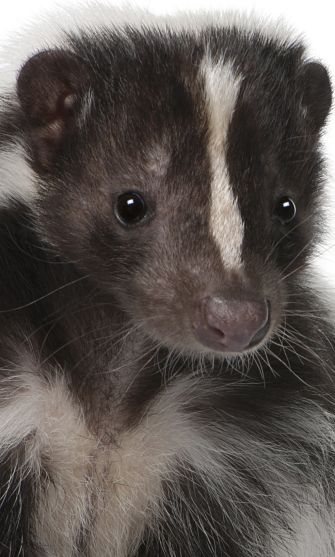 Portrait of a Skunk
Portrait of a SkunkThe skunk is a small, well-furred carnivore about the size of a house cat. It has iconic black and white markings, and the most notorious defense mechanism in the animal kingdom - the power of stench.
Once considered a member of the mustelid, or weasel family, which includes badgers and otters, skunks are now classified, since 1997, in their own family Mephitidae from the word "mephitical" meaning "noxious vapor". The new family includes 10 species of American skunks, and 2 species of old world animals called "stink badgers", which are native to Indonesia.
One of the Americas most recognizable animals is the striped skunk. Striped skunks are as wide-spread as any species in North America, and can be found in every state in the contiguos United States.
Striped skunks are crepuscular animals, meaning they are most active at dusk and dawn, and they spend most of their time digging and hunting for insects, grubs, mice, rats, and just about anything else they encounter.
They will eat fruits or vegetables occasionally, human garbage happily, and unattended dog and cat food too.
Most skunks are black and white in color, although brown is not uncommon, and albino individuals occur as well. Dramatic stripes or spots across the coat serve as a warning for predators to stay away, and for the most part, they do.
Only inexperienced animals will push the limits of a little skunk, and the skunk will give lots of warning if they are being harassed. Skunks will hiss, do little bluff-charges, stamp their feet, and, last but not least, do handstands while whisking their tails violently.
If the aggressor doesn't heed the warnings, the skunk finally faces it's raised tail towards the offender and releases a 10 foot stream of sulfuric anal juices. Like tear gas, the skunks anal secretions not only wreak, but also burn the eyes and mucous membranes of unfortunate victims.
Most animals, be they mountain lions, bear cubs or young coyotes, once sprayed, will never risk contact with a skunk again, and the skunks dramatic coloring makes it easy for their victims to remember them and avoid them in the future.
The only creature that preys on them regularly is the great horned owl, which, somehow, is not deterred by the odor or the stinging sensations. Many domestic dogs and cats though, for whatever reason, just don't seem to learn their lesson, some making a lifetime habit of getting "skunked".
While a bath in tomato juice is often used to try to remove the odor, the actual remedy is a mixture of baking soda, hydrogen peroxide, and liquid detergent - it's supposed to do the trick!

Although they try to avoid confrontation with humans, pets and predators, skunks are carnivorous hunters, possessing large sharp teeth and extremely long, curved claws.
They are generally helpful animals, ridding farms and suburban neighborhoods of all sorts of unwanted vermin, but can be destructive to lawns, sheds and the lower perimeters of homes as they dig and rip in search of grubs and mice.
For this reason, more than any other, the idea that skunks can make nice house pets is a challenged one. Skunks have been bred since the 1950's for the pet trade, and are offered for sale after having their anal glands surgically removed.
Pet skunks come in an assortment of colors beyond the classic black and white, with shades of lavender, apricot, cinnamon and champagne being most popular.
With their large, grape-sized anal glands removed, pet skunks can no longer spray, but they have other, smaller glands, located under their chins and throughout their bodies, that produce a musky odor, much like a ferret.
The issue of the musky smell comes down to personal tolerance, but the real concern with pet skunks is that their natural drive to dig and forage, usually leads to destruction of household items, furnishings, and fairly important things like flooring, drywall, and moldings.
With its strong shoulders, back, and forelimbs specially designed for digging, and claws like little steel tire-irons, a curious skunk can rip a baseboard loose in seconds, and even tear up ceramic tile.
Yes, skunks are cute, and more cuddly then you might expect, but investigate thoroughly before considering one as a pet!
skunk spray
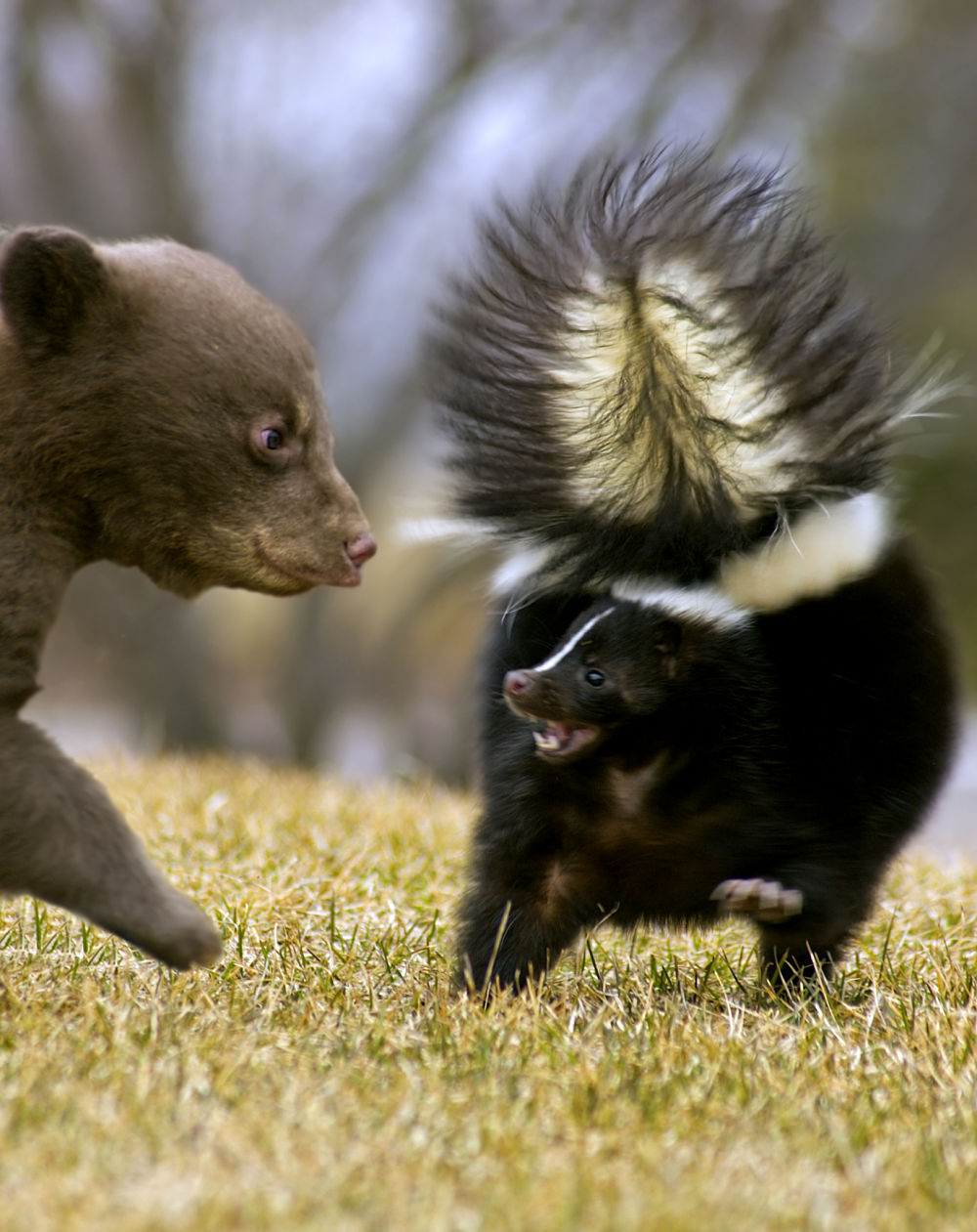
Most carnivores, including domestic dogs and cats, have anal glands. These are glands located on either side of the anus that create an oily, sulfuric substance with a powerful smell.
The secretions of the anal glands are stored in anal sacs, and when the animal has a bowel movement, some of the substance escapes onto the excrement, leaving a specific calling card of odors for any animals that follow.
Dogs greet each other by sniffing the anal glands. Other animals, such as badgers and mongooses, mark territory by pressing their rears against logs, stones, and other badgers.
But skunks use their anal glands as a weapon.
How these organs have evolved into such an amazing defense mechanism is unclear, but the skunks ability to project their sulfuric spray as far as 15 feet, aimed directly at the intended target, is unique, and truly amazing.
When ready to spray, two bright red nozzles project out of the anus, and a noxious, oily, golden stream of stink is hurled, with remarkable accuracy, directly at the intended target.
Skunks have precise control over these nozzles. If they can't see their target, in heavy brush for instance, they may expel more of a mist to cover a larger area, but if the harassing party is visible, the skunk will aim for the eyes, with a powerful sulfur spray that lands in thick, rain-sized drops.
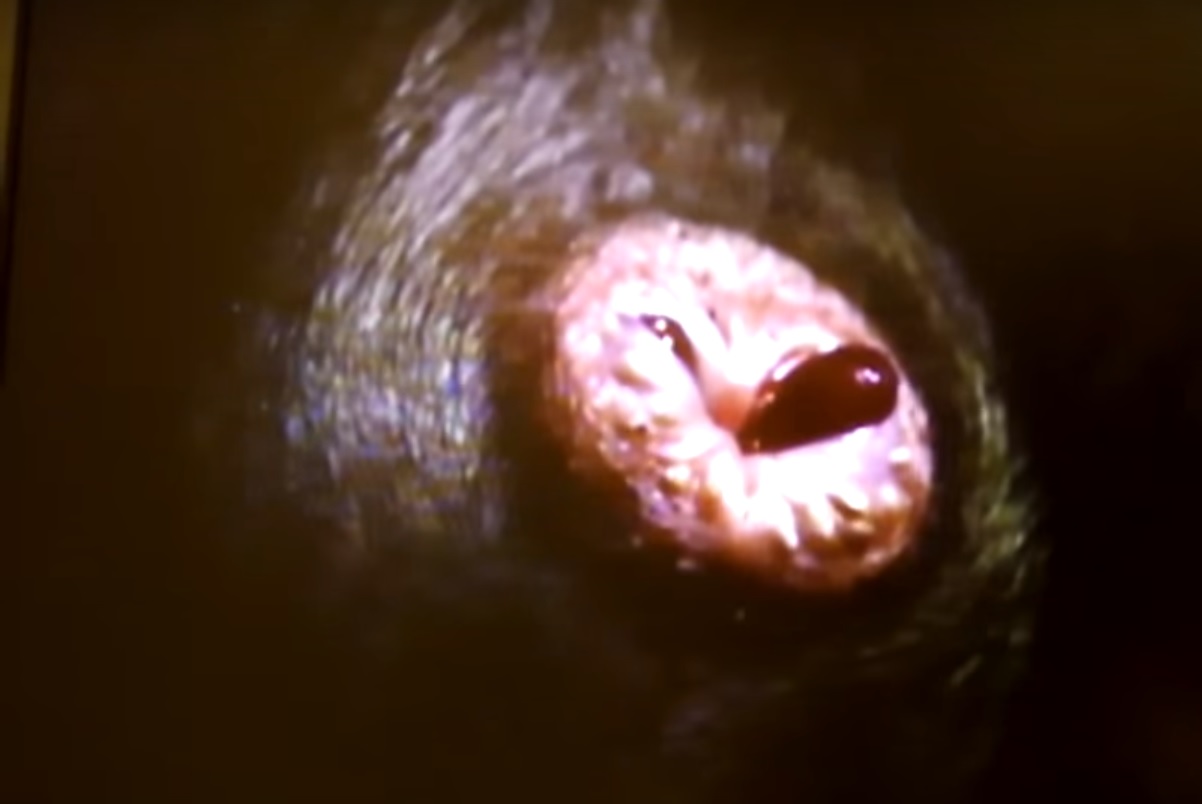 skunk sprayers close-up!!
skunk sprayers close-up!!Skunk spray is an entire recipe of chemicals, with seven volatile ingredients including a sulfur based thiol common in garlic and onions. The spray itself is extremely flammable, and the components are slightly different from species to species, to the point where experts can tell from the odor which species produced the stench.
Like being exposed to teargas, the victim may experience extreme discomfort, pain, difficulty breathing, and even temporary blindness. The odor will remain on hair, clothing, fur, skin and surroundings for days to weeks, and can be smelled from over a mile away.
The skunks two grape-sized anal glands contain a total of about 4 tablespoons of fluid, and most is expelled in a full-on event. It can take several days to replenish them, so skunks do not spray randomly, because without this remarkable line of defense, they would be relatively helpless against the large predators they encounter.
But whether their arsenal is depleted or not, they still go about their business with a bit of a brazen attitude, assuming they won't be pestered.
For this reason, it is the automobile, not the cougar or grizzly bear, that is the number one killer of skunks in North America. Folks who have accidentally hit a skunk on the road, occasionally report the animal raising its tail and spraying instead of running out of the way of the on-coming 3,000 pound vehicle, and we've all experienced that moment driving down the highway, when everyone hits the window buttons and covers their nose. - Amazing Skunk Facts
skunk lifestyle
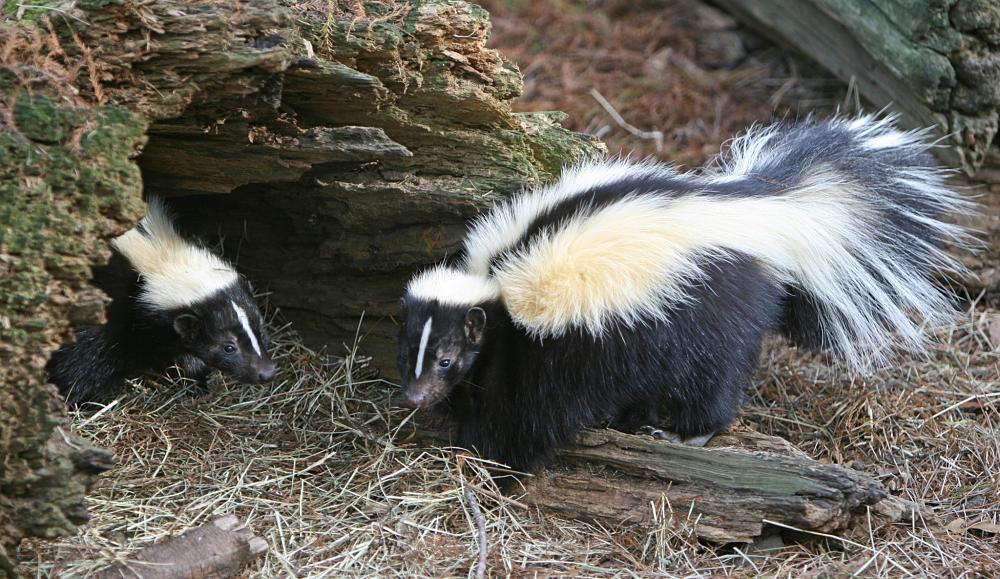
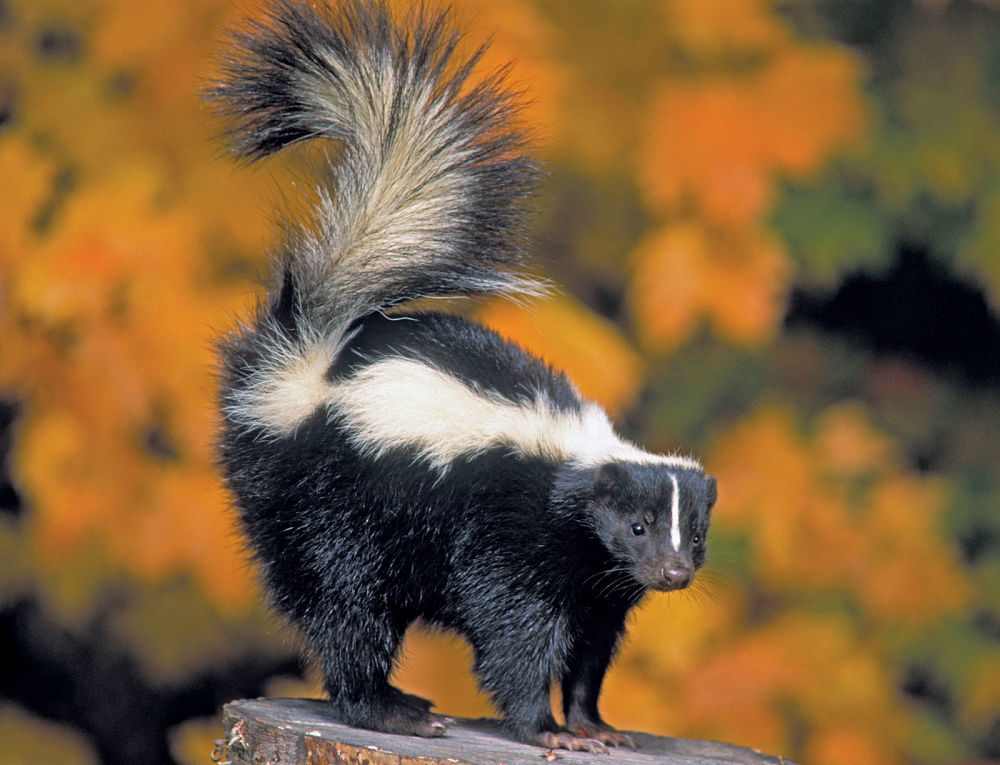
Skunks are solitary animals that sleep in nests or burrows during the day, and forage and hunt during the night. They are most active at dusk and dawn, making fairly regular rounds across their range, which is usually about 1 square mile.
Skunks are not territorial, and are not aggressive towards other skunks, except for mild skirmishes over food or den sites. These encounters are usually bluff sessions, rarely ending in any real confrontation, and almost never involving spraying eachother, except during mating season, when non-receptive females will spray persistent males, and both may spray if startled during breeding.
Striped skunks can be found in almost every habitat in the United States, but are most often found in areas known as ecotomes, where two different types of environments meet. Skunks are omnivores that will eat just about anything, and these margins offer the greatest variety of food stuffs.
Humans are the number one creators of ecotomes, planting lawns next to forests, parks in the middle of cities, and the traditional suburban layout of house/barn/garage/sheds, surrounded by lawn, surrounded by lush landscaping, across the street from a stripmall, is the ultimate ecotome!
Striped skunks thrive in these environments, and though the humans that engineered them may never see the creatures they share their handy work with, they benefit from the skunks active removal of a host of pests, like grubs, hornets, stinkbugs, rats and mice.
Skunks set up nests under porches or sheds, in old logs or woodpiles, and will also excavate their own underground burrows. One skunk may have as many as ten nests distributed throughout her range, and will rest and sleep in them in a random fashion.
They use their most secret and well-protected nest to bed down during winters in the Northern parts of their range. They don't actually hibernate, but in locations where winter temperatures fall below freezing, they will go into something called a torpor, which is a sleep period of reduced metabolism.
Unlike hibernation, which is a long term state of very low body temperature and metabolism, torpor is a lighter sleep, with only a slightly lowered body temperature, and the animal will wake up occasionally, especially if there is a warm day or two.
Over cold winter months, several skunks may actually den together, probably to retain body heat.
Skunks have a fantastic defense mechanism, and so there are few animals that will mess with them, but most birds of prey have a very poor sense of smell, and the great horned owl, in particular, has no problem eating a skunk.
But rattlesnakes have an excellent sense of smell, and will actually stop rattling and lay low if they smell the musk of an approaching skunk, because skunks feast on snakes, and appear to be immune to the venom of snakes, bees and scorpions.
Skunks will also eat a creature known as the stink beetle, which smells just as awful as them, and is also generally unmolested by most predators. Skunks will disarm these tasty morsels by rolling them violently around on the ground, waiting till they have expelled all their acrid chemicals. When the stinkbugs tank is empty, the skunk chows down.
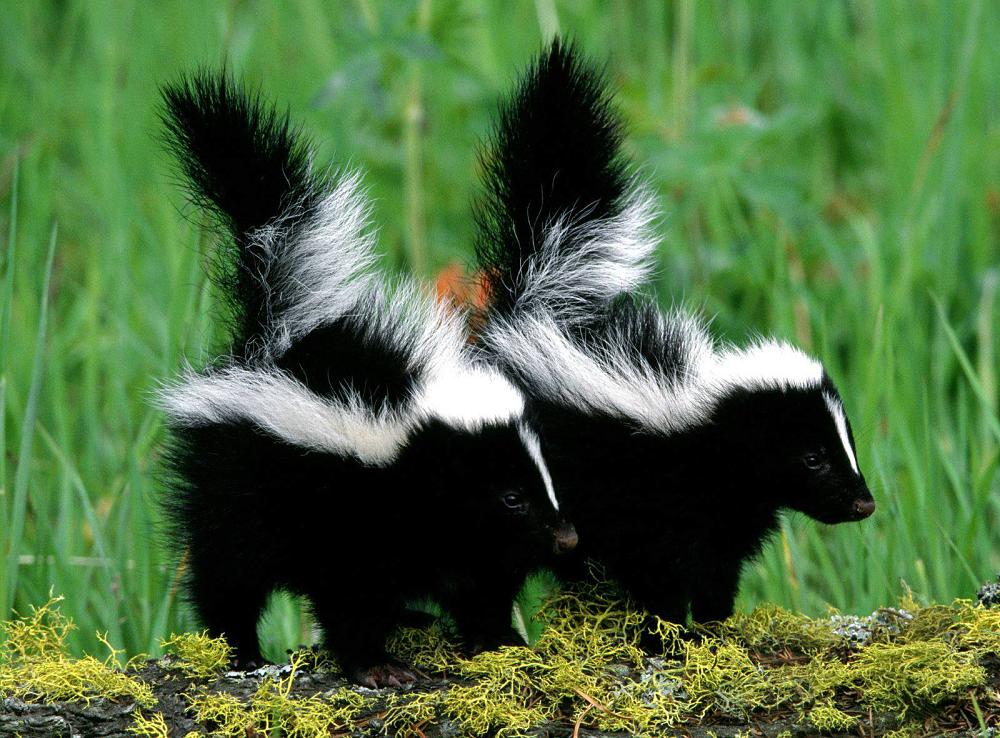 Baby Skunks!
Baby Skunks!skunk reproduction
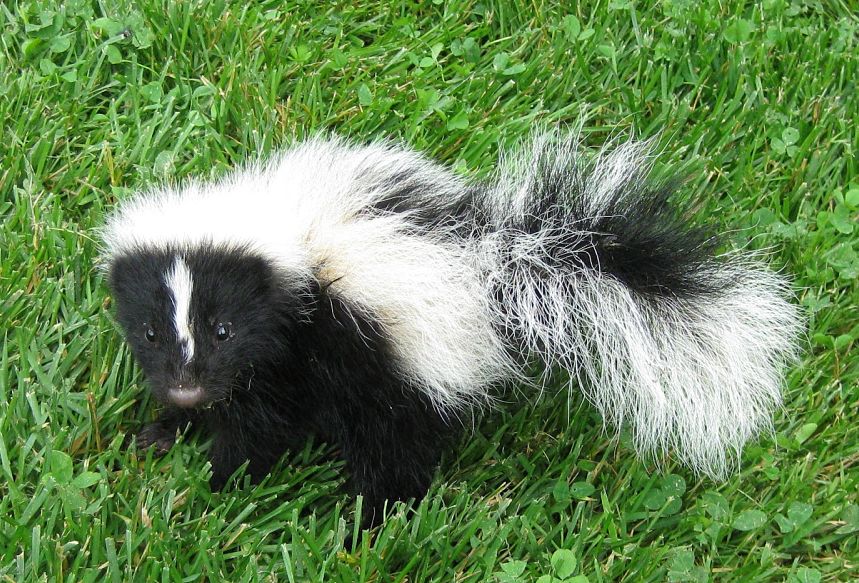 skunk baby
skunk baby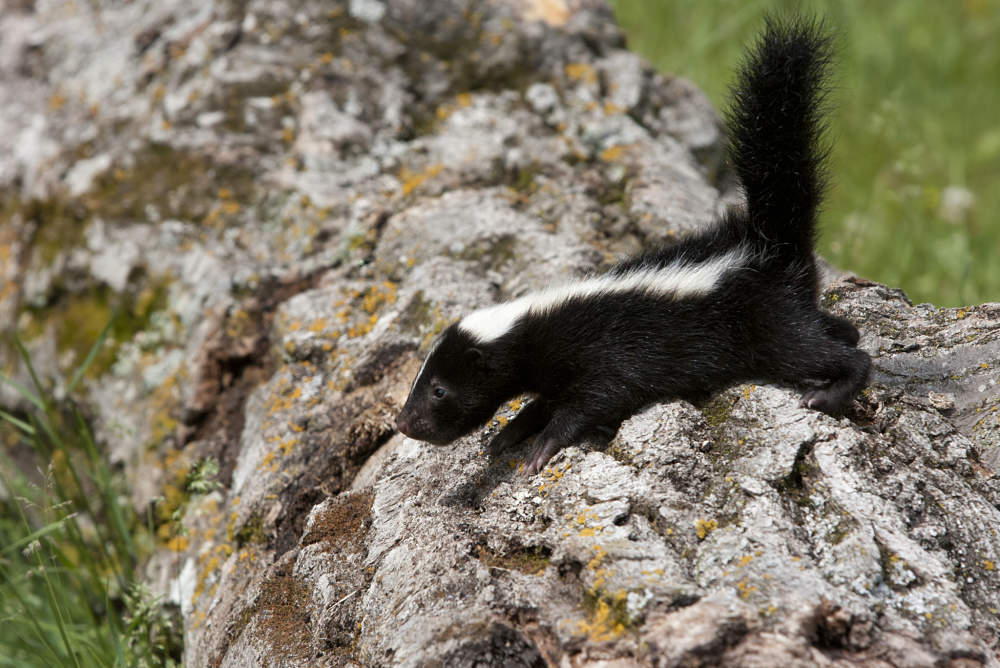
Breeding season for striped, hog-nosed and hooded skunks is mid-February to mid-April. In areas where there is a large skunk population, things can get pretty stinky at this time, and it is the most common time of year for dogs to get sprayed too.
Why? Well because skunks are so preoccupied with finding mates - as in multiple mates for both males and females - that they are easily startled, and a little anxious. Skunks also have a tendency to spray each other during this two month span, either while two males argue over a female, or when a female is not in the mood.
There is more of a battle than a courtship with skunks, and nightime screeching is commonly heard, but otherwise the mating is brief, and both male and female may have several partners over the course of a few days or weeks.
If a female conceives early in the season, the development of the fertilized eggs may be paused for a few weeks, in a process called delayed implantation. This insures that the babies will be born in the warmer months of May and June, when the winter is over, and food is more plentiful.
The mother prepares a nursery den, and will give birth to a litter of about 4 to 8 kittens, or kits. The newborn skunks are hairless and blind, but their bare skin has the stripe pattern already visible. They will begin to raise their tails when frightened in a matter of days, and can spray at about 3 or 4 weeks old - right about the time their eyes open.
The mother will start to leave the den with her little charges when they are 6 weeks old. They follow behind her in single file, and tend to maintain body contact with each other at all times when first out exploring. The family makes a lot of squeaking, gurgling type noises to keep in touch, and may seem to move as one bushy little unit.
Babies forage and start to hunt after about 2 months, and are off on their own at 8 months. - Skunk Facts
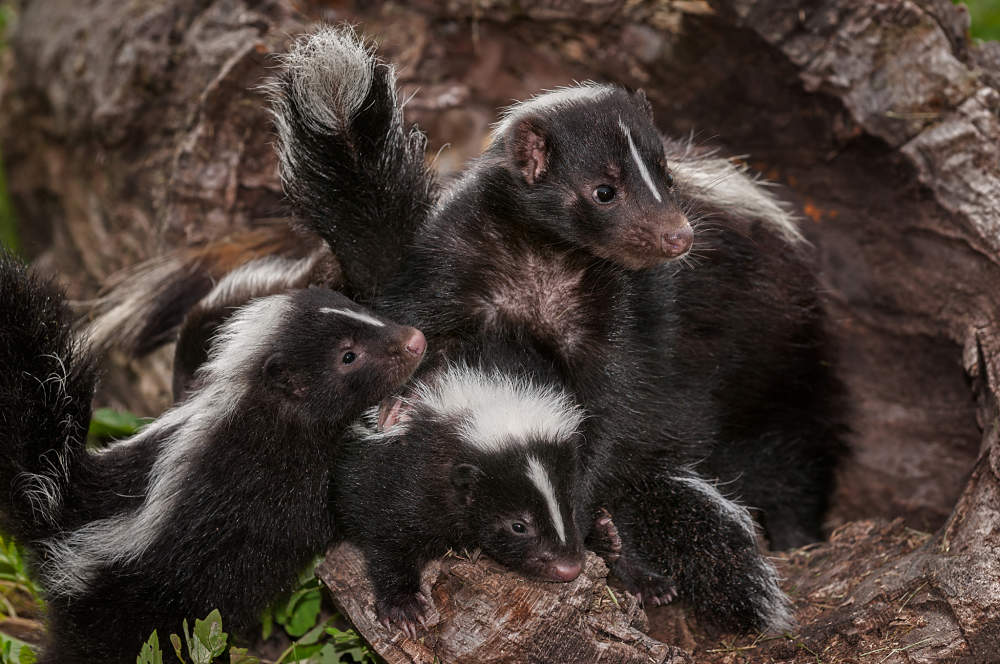 Skunk mother and babies
Skunk mother and babies
skunk species
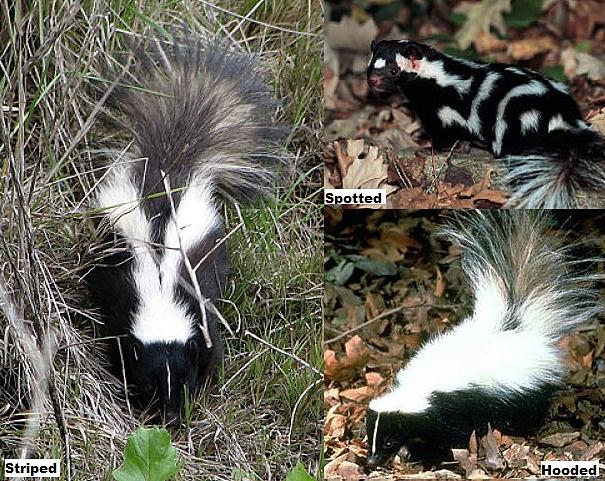
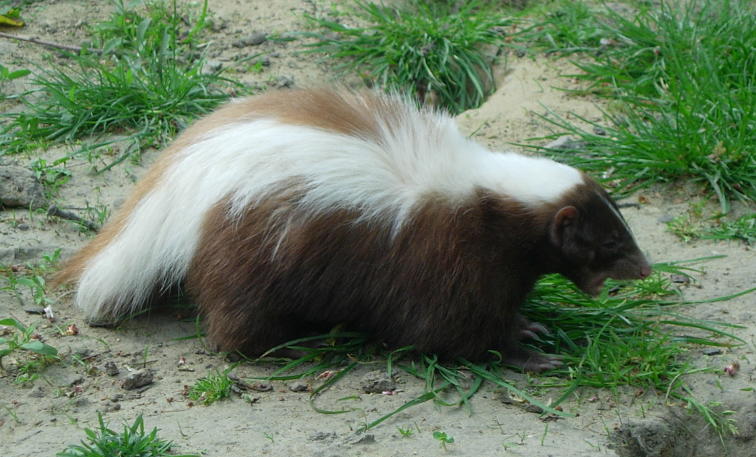 brown hog-nosed skunk
brown hog-nosed skunkThere are four species of skunks, striped, hooded, hog-nosed, and spotted.
The striped skunk is the classic animal most people think of when they think "skunk". Striped skunks occur in every one of the contiguous United States, in various habitats from seashore to city, desert to forest. They are small, cat-sized animals averaging about 6 pounds but getting as large as 16 pounds.
They are generally black, with a bold white splash that starts at the top of the head, splits into two stripes at the shoulders, and joins back into one stripe at the hips and down to the tip of the tail. This is the pattern that is seen most often, but markings can be quite variable across the population. Striped skunks have been seen in solid black to nearly solid white, with three or more stripes, and shades of brown instead of black.
Striped skunks are true ground dwellers that have no climbing ability at all. In fact, one of the more common skunk-related calls pest removal services get is when a skunk has fallen into a window well, sometimes no more than 2 feet deep, and can't climb out.
The hooded skunk is a little smaller than the striped skunk with a smaller range, but a very similar appearance. They are called hooded because of a ruff of fur they have around their necks. Like the striped skunks, hooded skunks are not very good climbers.
Hog-nosed skunks are common in the southwestern states, especially. There are several sub-species of hog-nosed, some of which can get larger than striped skunks, and several of which are brown and white in color. Hog-nosed skunks have well developed snouts for rooting through dry soil for scorpions and spiders. They will also trudge into caves filled with bats to pick off baby bats that have fallen to the guano-covered ground. Hog-nosed skunks are more agile than striped and hooded skunks, climbing rocky slopes and hillsides regularly.
The smallest skunk species is the spotted skunk, which rarely gets much bigger than 2 pounds or so. The spotted skunk is quite the opposite of the other species, in that it not only climbs, but actually hunts in trees.
They sleep in dens or burrows on the ground, but climb exceedingly well, and will even rob birds nests of eggs and chicks. Spotted skunks are the most elusive and secretive of the skunk species, though by far the most social, sometimes denning together in groups of 5 or more.
The tiny spotted skunk also has the most elaborate threat display of all the skunks, maybe because it is so small. They will do a full handstand with their tail and legs hoisted completely in the air in an attempt to appear larger. Spotted skunks can walk around on their front paws like this for several minutes, hoping their combatant disperses, but if push comes to shove, they will actually eject their spray from this odd position, leaving a very lasting memory.
a few more skunk facts
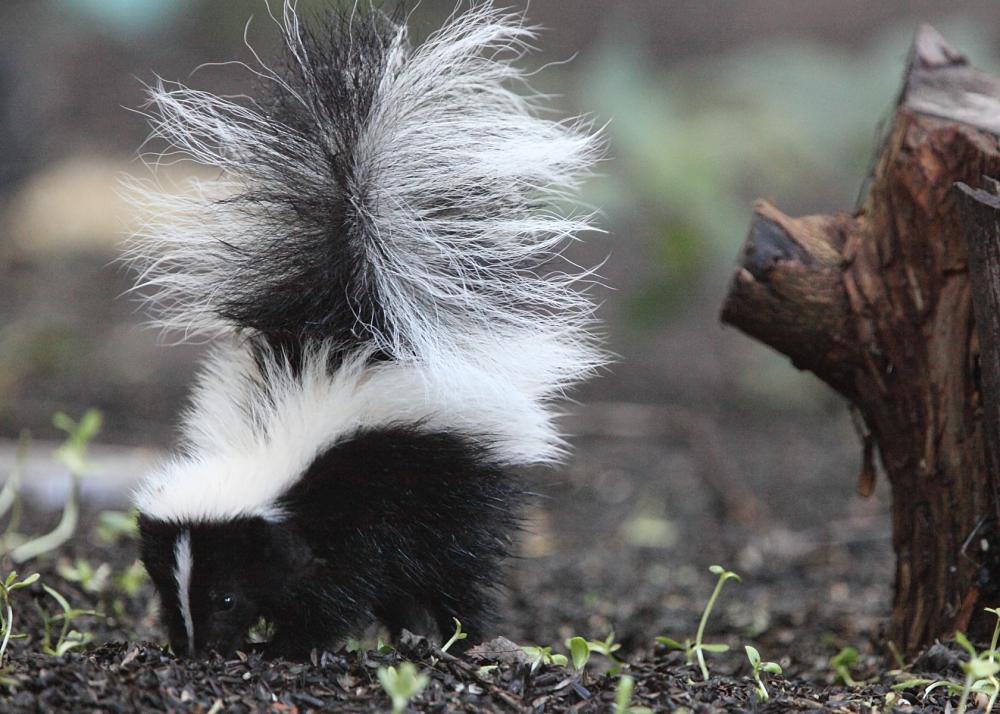
- Skunks can accurately spray up to 15 feet
- Skunk spray is not urine, it is the secretions of the anal glands
- The skunks bold coloring is a warning to stay away
- Skunks almost never spray eachother, except during mating season
- The only thing that eats skunks regularly is the Great horned owl
- Great horned owls have a very poor sense of smell!
- Skunks are immune to rattlesnake venom, bee stings and scorpions, and will eat all of them
- Some people keep skunks as pets
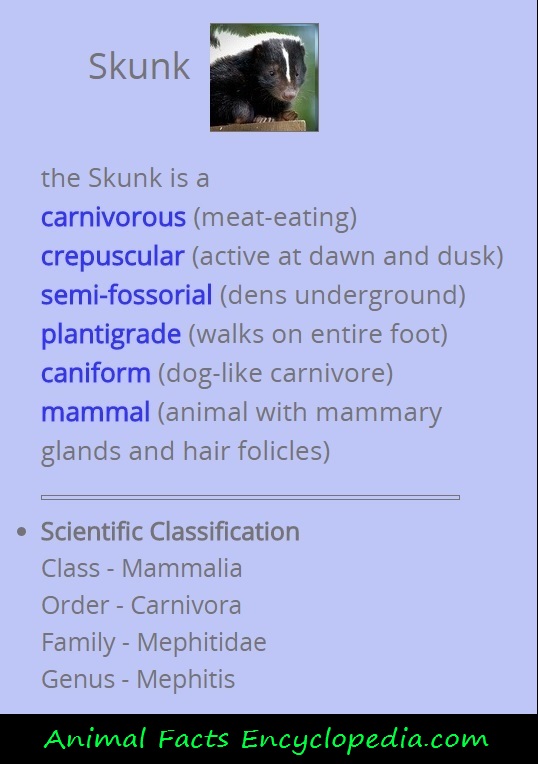
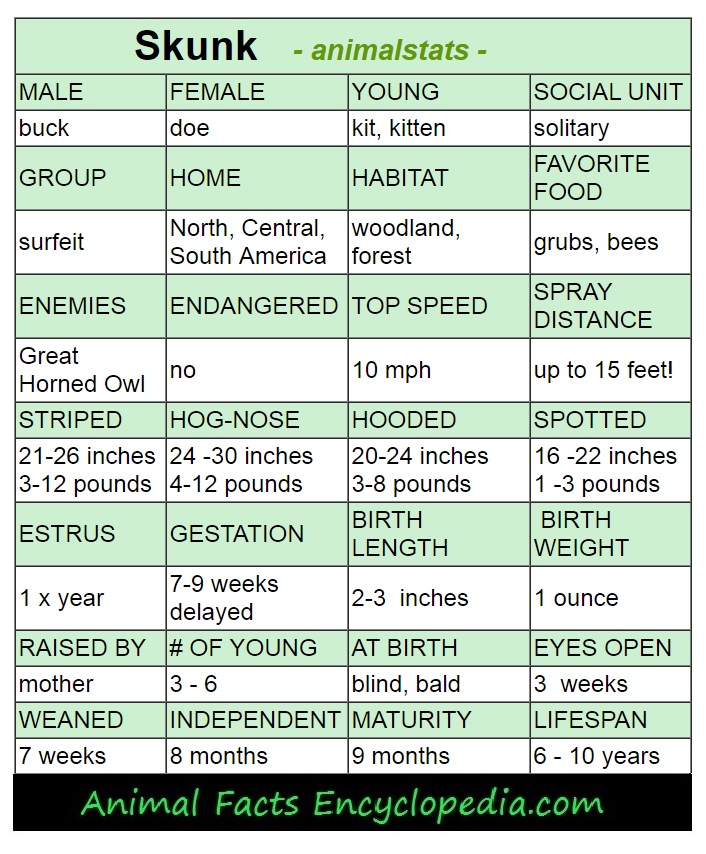
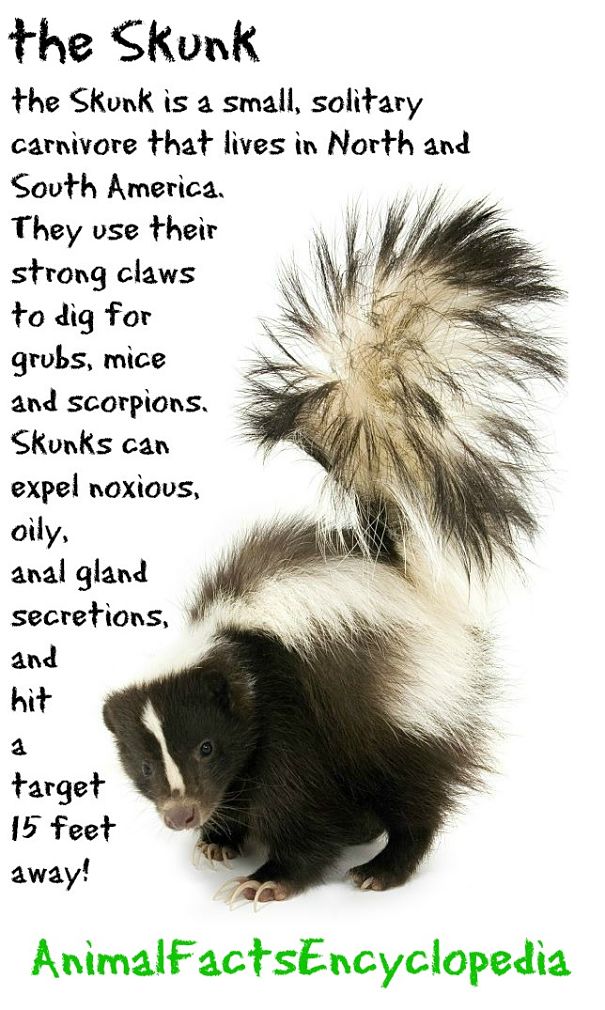
see more animal extreme closeups
Recent Articles
-
African Animals - Animal Facts Encyclopedia
Oct 11, 16 10:27 PM
African Animals facts photos and videos..Africa is a wonderland for animal lovers, and a schoolroom for anyone who wants to learn about nature, beauty and the rhythm of life -
Baboon Facts - Animal Facts Encyclopedia
Oct 11, 16 10:26 PM
Baboon facts, photos, videos and information - Baboons are very distinctive looking monkeys with long, dog-like snouts and close set eyes. -
Great Apes Facts - Animal Facts Encyclopedia
Oct 11, 16 10:25 PM
Great apes facts, photos and videos..Human beings did not evolve from chimpanzees, modern chimps and gorillas do not appear in the fossil records until much more recently than homo sapiens..

























